In my honest opinion, most value propositions out there suck, and in this article, I’ll tell you why that’s the case, where and why companies go wrong, and how to get value propositions right.
I’ll share a case study from my own experience crafting a differentiated value proposition at my organization, and take you through how we approached it step- by-step as an indicative example for you to take back to your own workplaces.
My name's Abdul Rastagar and I want to talk about value propositions because I think most value propositions out there suck, they really do.
I feel that way because, for the most part, we write them from our perspective with our business objectives in mind, rather than really think about the customer and why they're looking for a product or solution in the first place.
We end up talking about features and functionalities and tech talk and all these fancy bells and whistles. The customer really, at the end of the day, just wants to solve their problem.
The agenda
This is a problem that I came across a lot in the past, so I developed this structured methodology for myself that guided me through that process as we were launching products to the market. That's what I want to share with you today.
It's not the only way of doing it, but hopefully, it'll inspire you to think a little bit about it as well. This was developed in the context of the B2B software space, I came from that world, but I did try and put some B2C examples in there as well.
Does anybody know what this is?

Microsoft Zune
Microsoft's competitor or answer to the Apple iPod. The Zune was released in 2005, did you own one? I've never met anybody who's owned the Zune, and the thing is, I remember when it came out the tech reviews were fabulous.
People were raving about what a fantastic product it was, and yet the product was retired in 2011 because it got no market traction, only about 1% market share. I'm going to talk about why that happened from a marketing perspective. There are many reasons here.
About me
But before I go on, let me tell you a little bit about myself...
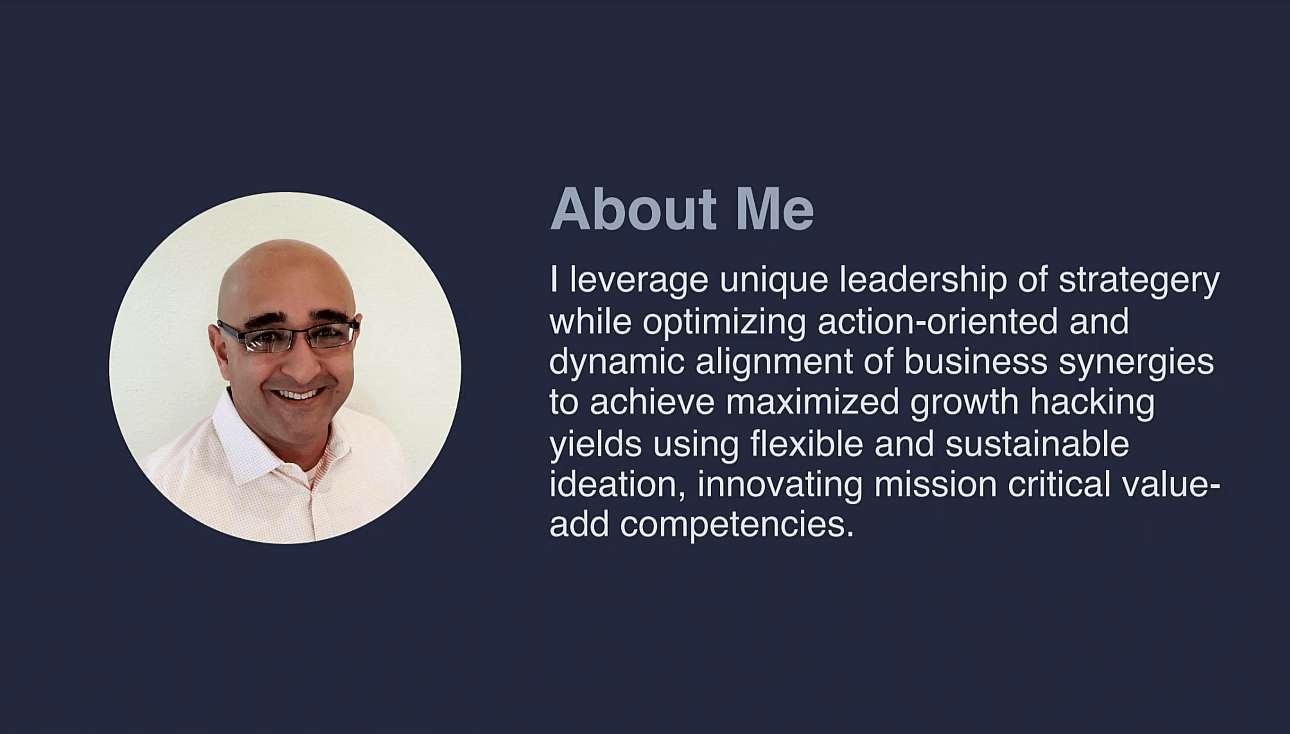
Please don't take this image seriously, this is to give you an example of the kind of garbage language we use in the business world, to hide behind the fact we don't have any value propositions. We don't do a good job at it, so we come up with this type of language.
You see this sometimes on LinkedIn, maybe not this dramatic, but it's out there. This is particularly true in the B2B world and I think as product marketers, this is where we come in to make sure that we don't end up talking like that.
We truly talk about value when we are in front of a customer, I'm going to define what that means in this article and what value means to me.
Words are free
The way you position yourself, the words you use, and how you go to market really matter in the perception of the customer. I think this is where product marketing, can really add strategic value to the organization, this is where we come in.

Examples of poor value propositions
These are some examples of value propositions that suck.
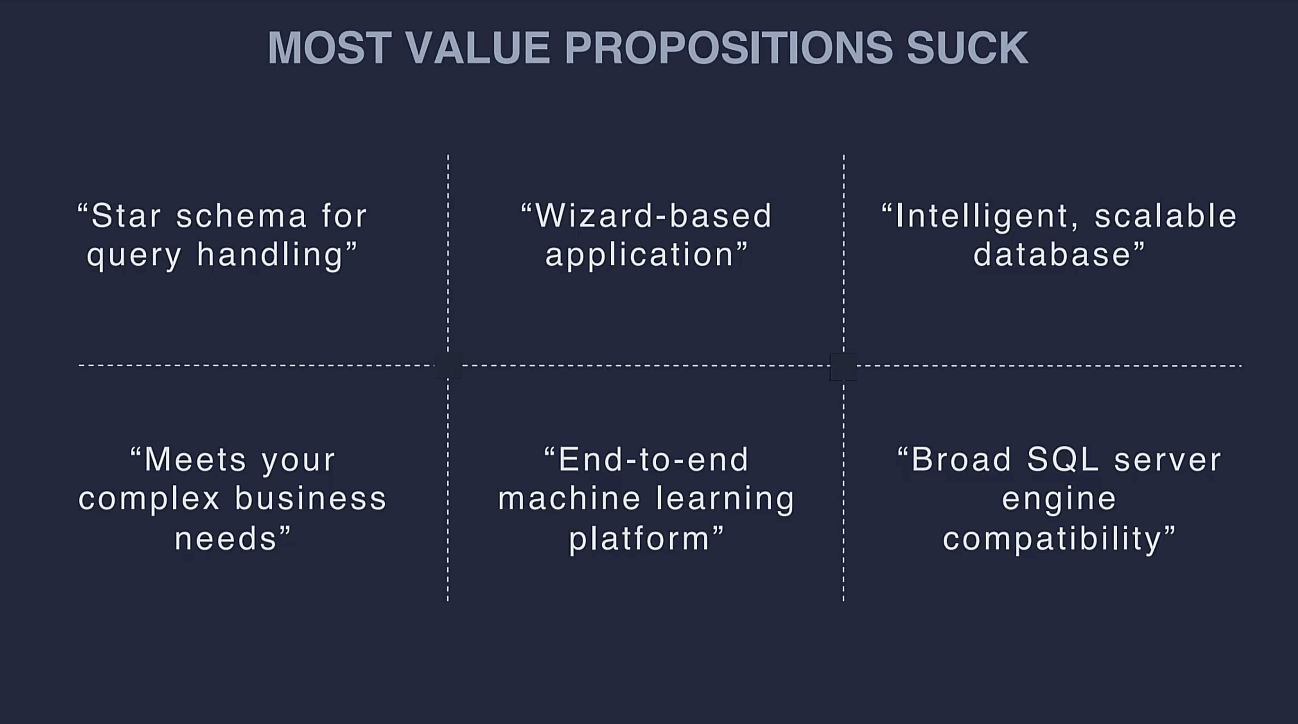
All of that feature and functionality talk, these are actual value propositions that are on Fortune 100 company's websites today, telling you about why you should buy their product. It's either Tech Talk or at some random ‘meets your complex business needs’ without any definition of what value is.
It's clearly not written from the customer's perspective, you have no idea why you should buy it. That's unfortunate.
Maybe they’re for specific audiences?
This happens very frequently and you could say, "Well, maybe some of these are IT messages, maybe the audience is an IT audience". Even an IT person will buy a product because of a business need they need to fill.
They don't get up in the morning and say, "Oh, gee, I really want an intelligent, scalable database system today so I'm gonna go buy one." Nobody does.
Business drives: an example
I'll give you an example of an IT director at British Airways. I flew from Reykjavík airport to Heathrow and I checked in my luggage at the airport. When I got to Heathrow, my luggage wasn't there. But BA was able to track it very quickly and reunite me with it within two hours.
That's because somebody on the back end had probably bought an intelligent, scalable database to help them manage that operation. That is their business driver right there, they're concerned about making sure they reunite the customer with their luggage because then the customer is more satisfied, the customer's probably gonna be more loyal because of it and presumably, that leads to more revenue as well.
Those are some of the drivers.
Where does this language come from?
The reason we come up with buzzwords, like ‘end-to-end machine learning platform’ is because in many cases this is driven by our colleagues - product managers (who I absolutely adore, I'm not criticizing here by any means).
A lot of them come from a technology background, they don't really come from a sales-driven perspective. They sit with the end-user and talk to them about "Hey, what do we need to do for you guys?" and the end-user will say, "I spend a lot of time coding, I wish this was easier. I wish I had some sort of wizard" or whatever, and we put that into the requirements.
Then marketing comes along and says, "We're about to launch this product, what do we say about it?" The product manager will say, "Well, they really want a wizard". That's where you get that kind of language up on the website, maybe if they're good, they'll change that to 'easy to use'.
I have news for you - easy to use is not a value proposition, neither is configurable. I'm sorry, I hate to say it, but those are bad. Those are functionalities of the product and easy to use at this point, in 2021, if your product's not easy to use, you've got other issues.
Back to the Zune
Let's think about when we talk about value propositions, what are some examples of how can we really provide good value propositions? This takes me back to the Zune.
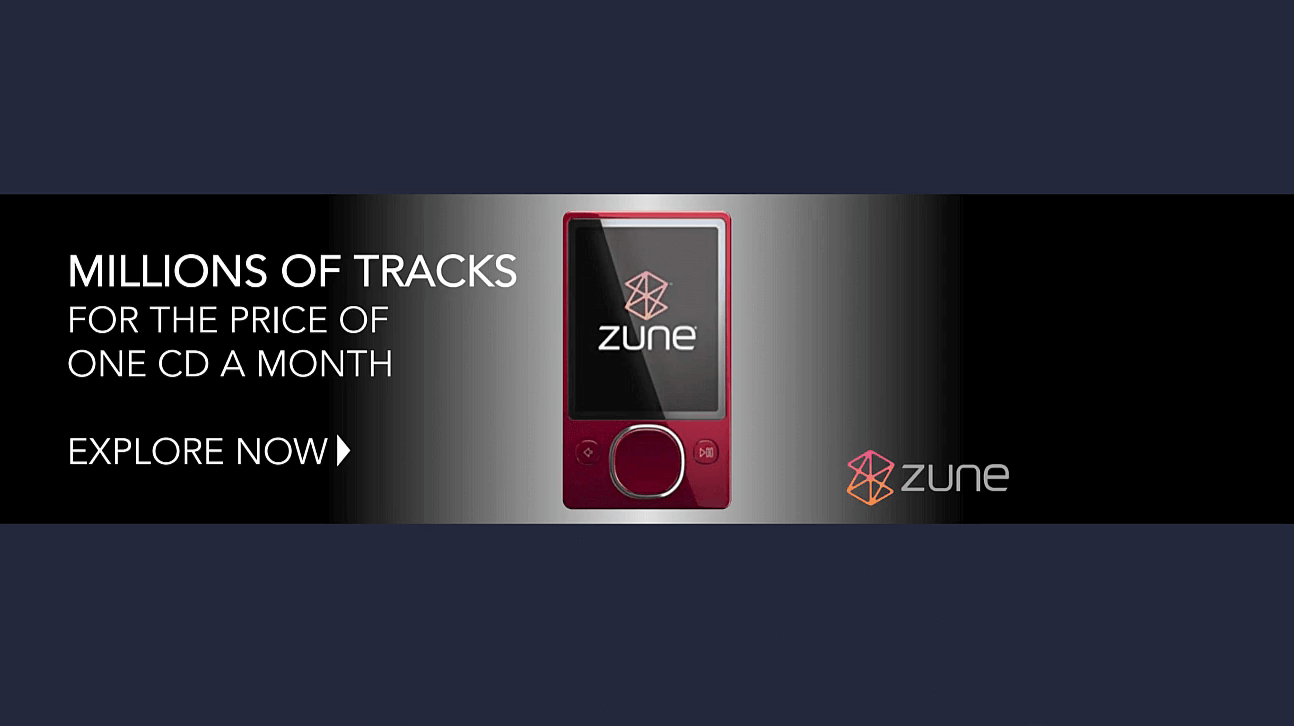
Millions of tracks for the price of one CD a month. This was an actual ad from Zune and this was actually very emblematic of a lot of their ads. They had one where it was a large picture of an iPod, and it said, $29,700 - if you fill this 120 gigabyte iPod with music, it'll cost you that much money, or you can buy the Zune for a monthly subscription and get the same amount of music.
Their strategy was to go after the iPod, “As good as the iPod, but cheaper”. That may make sense in some cases, but if you think back in the early 2000s, what was Microsoft? It was the big stodgy monopoly that nobody really liked and the products, people were kind of tired of the constant crashing.
People were actually moving to Apple because not only was the technology different or perceived better, but also it was cutting edge, it was trendy, it said something about you. If you walked into the coffee shop with your Apple product, it was saying it's a lifestyle purchase, I'm rejecting Microsoft, I'm buying something new and innovative.
To do this, people were buying two to three times the price for the equivalent Microsoft product. So to go to that market and say we're going to do it for you for cheaper, it's not really the right message because that message doesn't connect with what their pain point was.
Microsoft is one of my favorite companies, by the way, I have so much respect for them. I'm not doing anything to criticize them here, it's just hindsight is 20/20. But it brings up an important point.
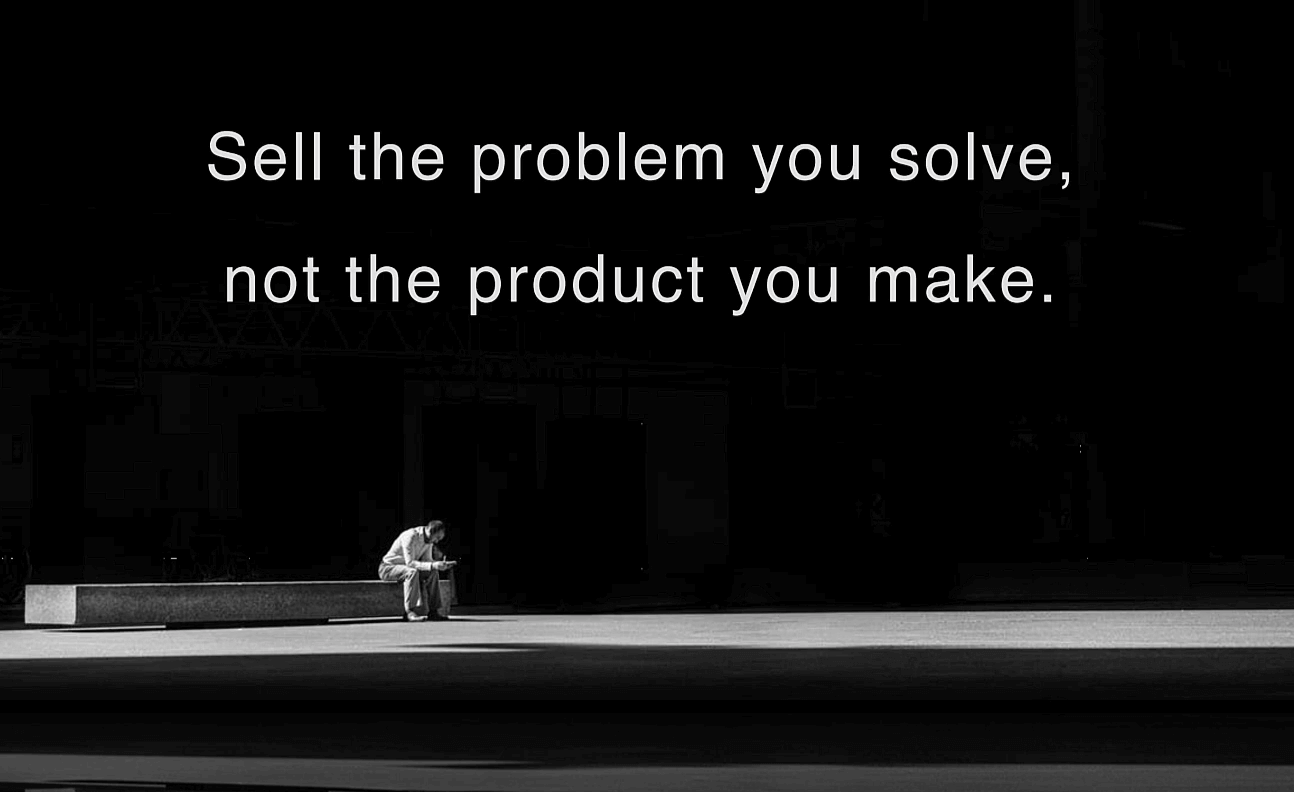
Sell the problem you solve, not the product you make
Your customers are getting up and trying to solve a real business problem, that's why they're talking to you. If you think about an HR manager, they want to get an applicant tracking system, not for the sake of having an ATS but because they have a pain point.
That pain point may be they need to hire for a certain position, their hiring manager is calling him every single day saying where is my candidate flow? Where's my flow of candidate resumes to look at? And the HR manager says, "Well, I've got a tonne of them, I can't process them fast enough. And when I do find somebody who seems good, by the time I call him or her, they've already been hired by the competition".
Their pain point is to process those resumes faster, so they can get the right candidates faster to the hiring manager. That's why they're talking to you about an HR applicant tracking system. No other reason.
Remember...
I'm going to make one really important point here. If you're in the B2B world, also B2C, but especially B2B, no one will actually purchase your product if they can solve that problem on their own.
They're only looking for you as a secondary path. If they can solve that problem without any technology, they will absolutely do it, and they'll never even think twice, and you'll never have an opportunity to present your solution.
Really think about that when you do your value propositions.
How to build a value proposition framework
There are four steps to this framework.
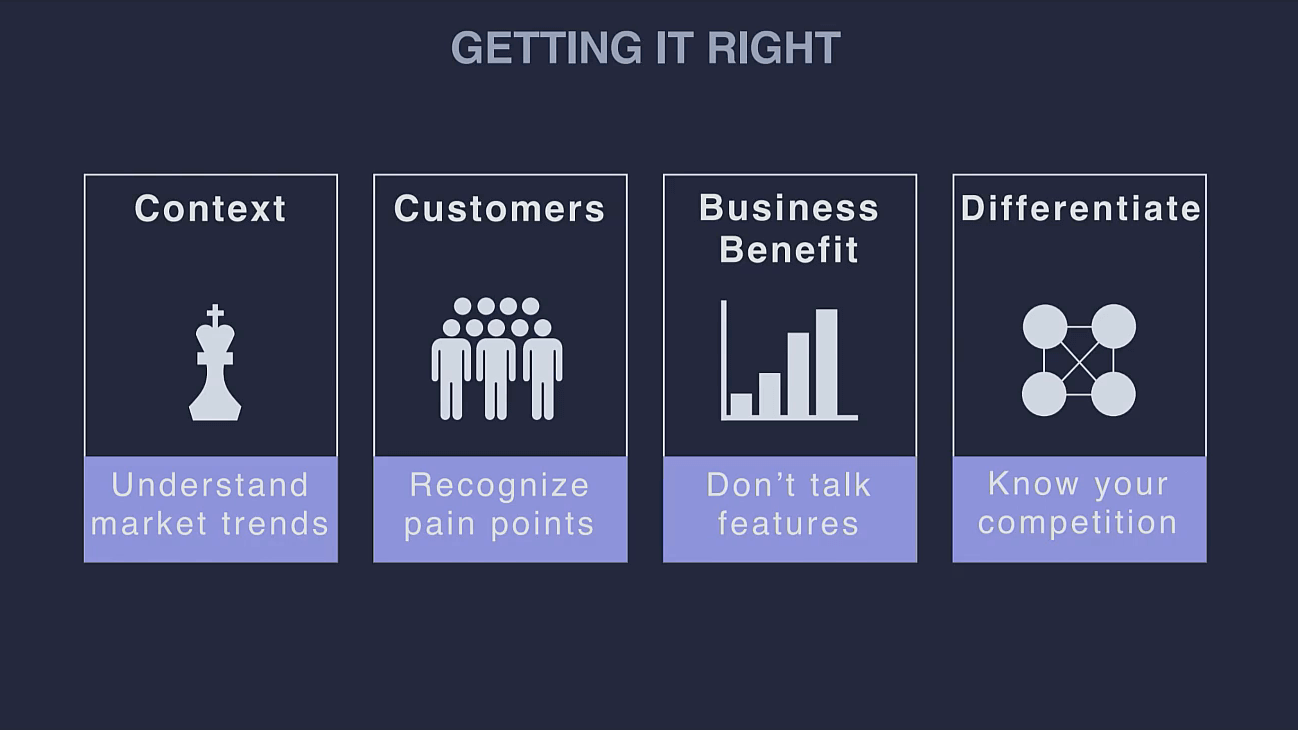
Context
There's the context in which your customers operate, not you, but your customers.
- What are the macro trends that are affecting them?
- What are the environmental trends?
- Is a recession coming?
- Is there perhaps a generational shift? People are retiring and a new generation of users have different user behaviors.
- It could be compliance requirements, GDPR, or California data privacy laws coming into effect next month that apply to anybody whether they are based in the US or not.
- Is Brexit going to happen?
Those kinds of macro factors are always influencing your customers.
Customers
Second, you need to understand their pain points. I mentioned the IT Director at British Airways and the hiring manager looking for an ATS solution. There are dozens and dozens of examples of that.
Only once you have identified those aspects, can you go to point number three.
Business benefit
Start thinking about yourself. How do our products and solutions map to those pain points?
Again, business benefits - features and functions don't have a place here, they're important for an RP or a product demo, but they don't have a role in your benefit statements.
Differentiate
Finally, you can do the first three perfectly, but if you don't get the fourth one right, it's very difficult to be successful. Because if every single vendor or solution out there looks the same, what does the customer base their decision on?
They're going to base their decision on price. You're going to be the low-cost vendor. That works for some, but in general, that's not a sustainable strategy.
A simple test
Really think twice about what your competition does, in fact, a really interesting test that I hope everybody here does - download your competitors’ datasheets, if you haven't already, take off all the logos, branding, and colors so you just have the copy of their datasheet and then put yours side-by-side and give it to one of your customers.
Ask them to identify which one's your product. I almost guarantee they won't be able to in many cases, you'll be shocked that you won't be able to do it in some cases. This is a very common phenomenon.
When you can't differentiate yourself from the competition, you're struggling and that's very common.
Examples of good value propositions
Here's an example of some value propositions that are done right.
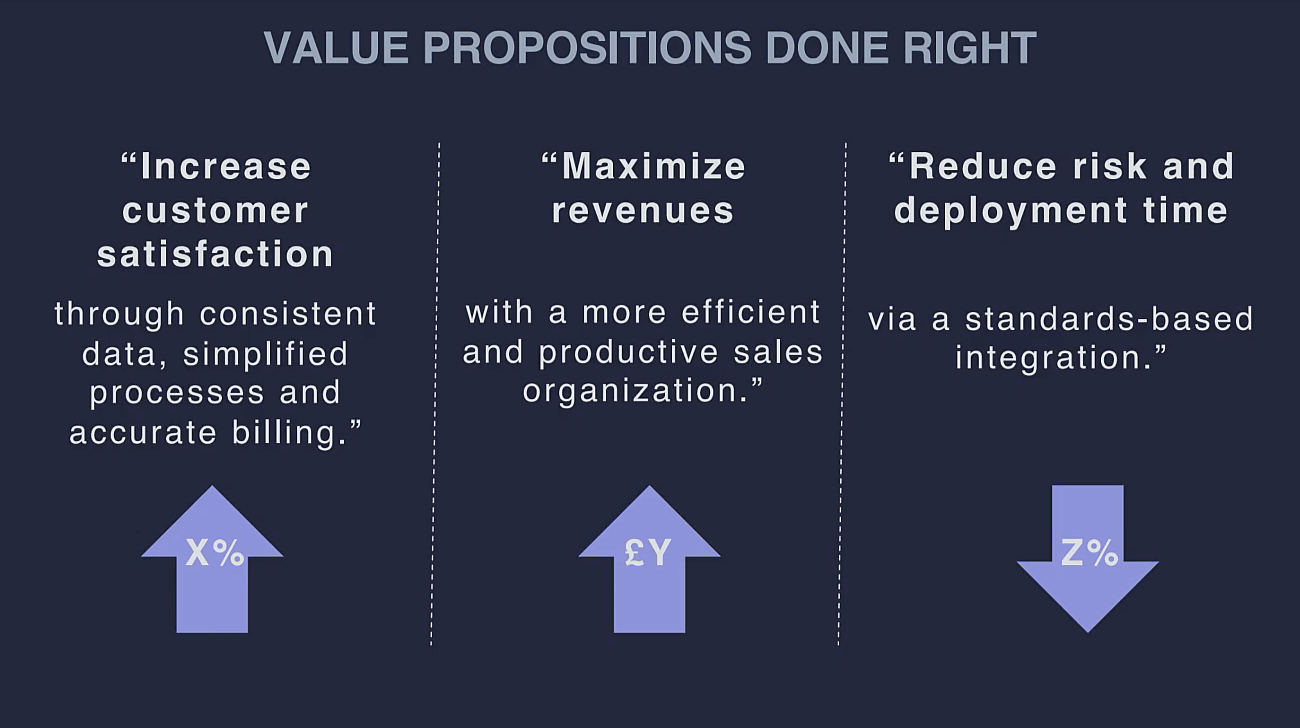
Increased customer satisfaction, maximize your revenues, and reduce risk and deployment time. Those are three value propositions that this organization fell for their product.
Are they business-oriented to their customers’ needs? They seem like it, they seem pretty relevant. I don't know that business well enough.
Are they differentiated? I don't have that context, let's give them the benefit of the doubt.
But certainly, there's no feature functionality talk in here, there's no Tech Talk. It's trying to pin their benefits to their customers’ presumed pain point. They do it through:
- Increased satisfaction = consistent data, and simplified billing.
- Maximizing revenues = making your sales org more productive.
- Reducing risk and deployment time = with an integration.
Notice they're talking technology here but that's okay because the integration is not the value proposition. The value proposition is we're going to reduce your risk and deployment time, the integration is just the proof point, the enabler of how we do it.
Three is key
I really like this because it's business-centric and differentiated. It also comes in three, three is a key number because if you start giving more than three value messages, you're going to confuse people, they're going to forget, they're not going to remember what you said.
If you do less than three, it's almost impossible to differentiate from the competition, you have to be really special to be able to differentiate under three value pops.
That's a golden number right there.
Room for improvement
The only thing I would do in addition is to quantify this. Tell me how much you've increased customer satisfaction for a customer similar to me, perhaps build me a model that shows me how much more money I can make through this, at least to give me an idea.
Reducing deployment time, maybe the standard in the industry is six months, and you do it in 15 days, you can quantify all those things.
That's very complicated and time-consuming. In many cases, we don't like the numbers that come out at the end so we don't do it often. But if you can do it, and if you have strong numbers, absolutely this is an imperative here to do it.
We have to challenge ourselves to be better than the previous image about wizards and scalable databases.
Customers don't buy products, they buy solved problems
This is probably the single most important takeaway.
I mentioned earlier if they can solve their problem without you they will, they won't even think twice about you. That's just the way we operate.
How to differentiate a value proposition
Now I'm going to switch gears and look at an actual case study of an example I went through with my team a few years ago. I hope this will be an indicative example. You're not going to be able to reproduce it point by point, but it'll give you an idea.
Understand the context
Our customers were in an industry that was in a crisis mode because they were in a crisis of innovation and productivity.
Rising cost
They were spending money hand over fist year after year and looking at the blue line going up sharply, you don't even have to read the numbers to see that it's sharply increasing in spend - 50 fold actually over the 40-year timeframe.
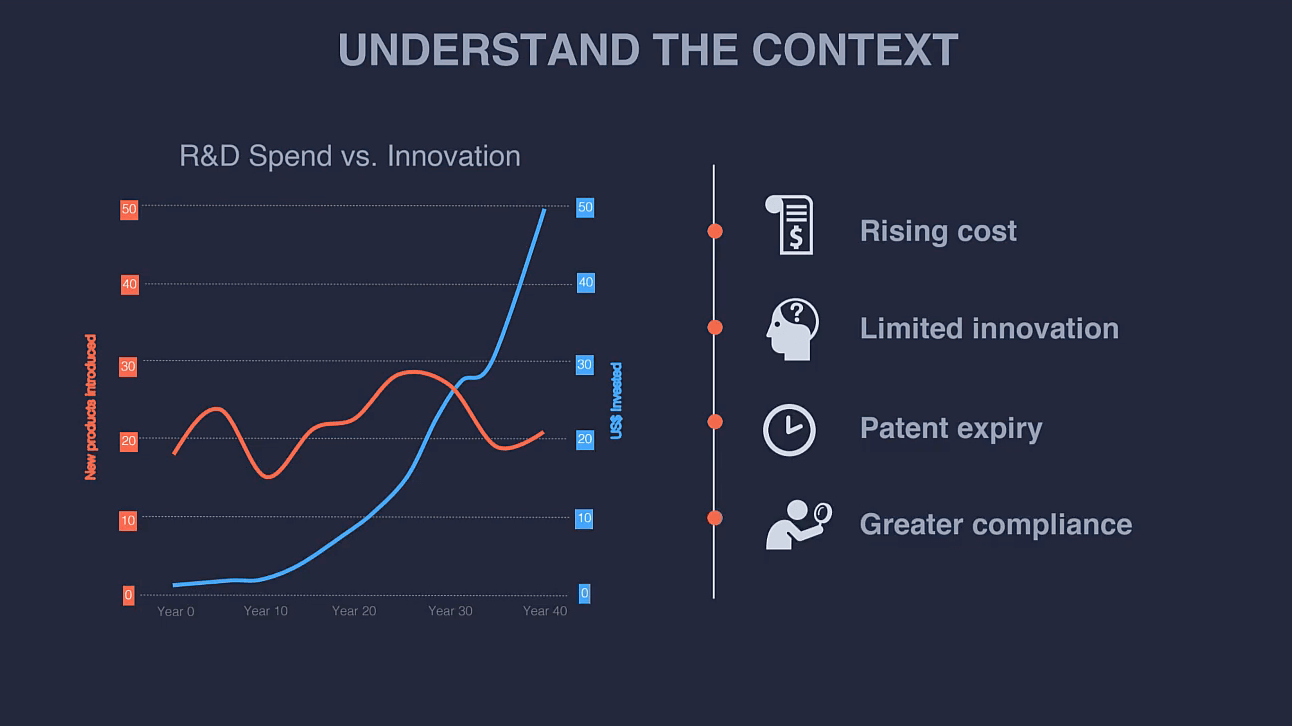
Limited innovation
But the number of products they were producing year after year was essentially the same. There were some peaks and troughs, but at the end of the day, they were introducing the same number of products each year.
Patent expiry
That was a problem because the ROI is not there. The other problem is their patents are expiring on the older products, remember, this is a long time frame.
Me too competitors are coming in taking away market share with much cheaper products, which they didn't have to invest any money into and these companies are really suffering in terms of profitability as a result.
Greater compliance
This was a regulated industry so the government's always looking over their shoulders, making things more complicated for them as well.
That's the context our customers found themselves in.
How to understand market competition
The problem for us was as vendors serving this, there were other vendors as well and we all looked alike. The other problem was we had actually differentiated ourselves through price - we were by far the most expensive.
It was fine because for years, that industry was making lots of money, and they didn't really care that much about money. But now all of a sudden, they're very price sensitive and we're starting to lose deals much more regularly, we're actually having customers move away from us, and explicitly citing cost as the number one criteria.
Even though we had the largest market share, we were starting to realize if we don't adapt and evolve, we're going to be in trouble. So we needed to adapt with our customers as their environment was changing.
What we did: Value proposition workshop
What we did is create a two-day off-site, that was called a value proposition workshop. It was done with all of these customer-facing teams brought together in one place.
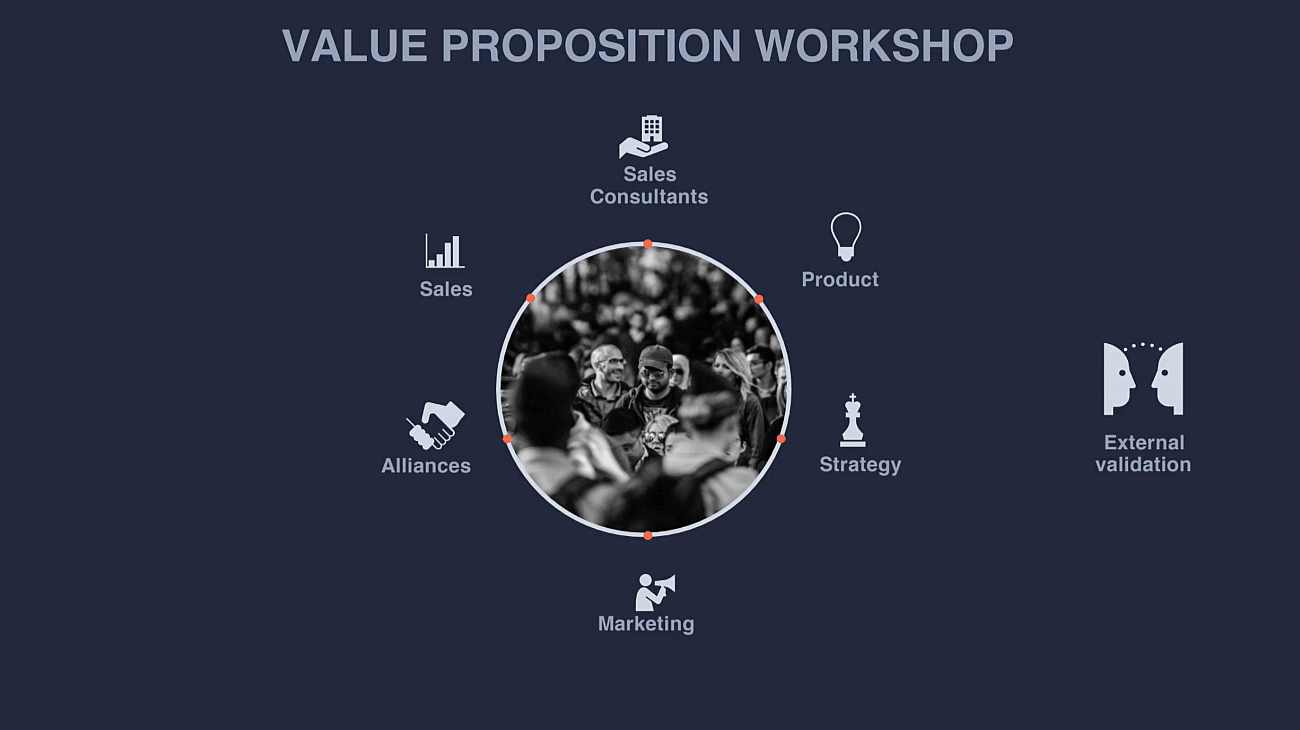
This was the first time our organization had done that, bring all of these diverse teams together in one place and one time to talk about what the customers business context is, what their pain points are, all those steps from the framework I mentioned, how our business benefits map to their needs, and ultimately, how we differentiate.
Coordination, buy-in, & commitment
This was an exercise that took a lot of coordination, it took buy-in from executive management, especially on the sales side, they're going to take a sales director out of the field for two days to talk about this stuff, that's a big deal.
There was commitment here at the most senior levels of the organization.
By the way, we reinvented ourselves across the board, across the organization, but I'm obviously just going to go through the go-to-market aspect of it today.
External validation
Once we came up with what we thought was a good set of value propositions out of this workshop, we had gotten external validation, we had some partners we work with that we're very close with, and some long term customers that we're very close with, we were able to get feedback from them and adjust our message accordingly.
How to understand your customer
Then we looked at, what do we do here? Let's drill down. We looked at the people who are making the buying decision.
Buying committee
For us, it's those three individuals in the middle, the VP of Business, Business Operations, and End User, basically the line of business that makes the decision.
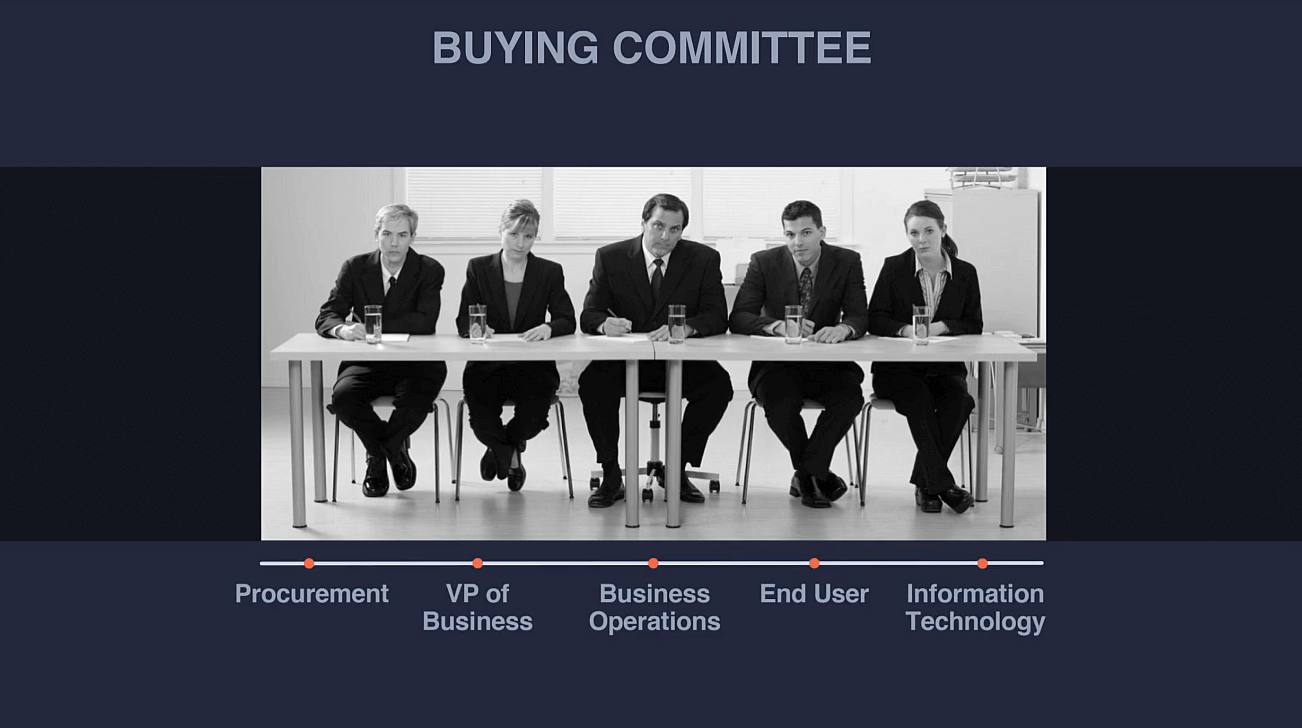
We have historically very strong relationships with that line of business. That was one of the key reasons we tended to win.
IT over on the far end, they're important influencers in this decision, extremely important but they were neutral to us. They didn't really like us, they didn't have any particular affinity for us but they didn't dislike us either. As long as we met their checkpoints - good enough.
The problem for us was procurement because what does procurement care about? Cost is what they care about and in this particular industry compliance as well. Those were the two things they cared about.
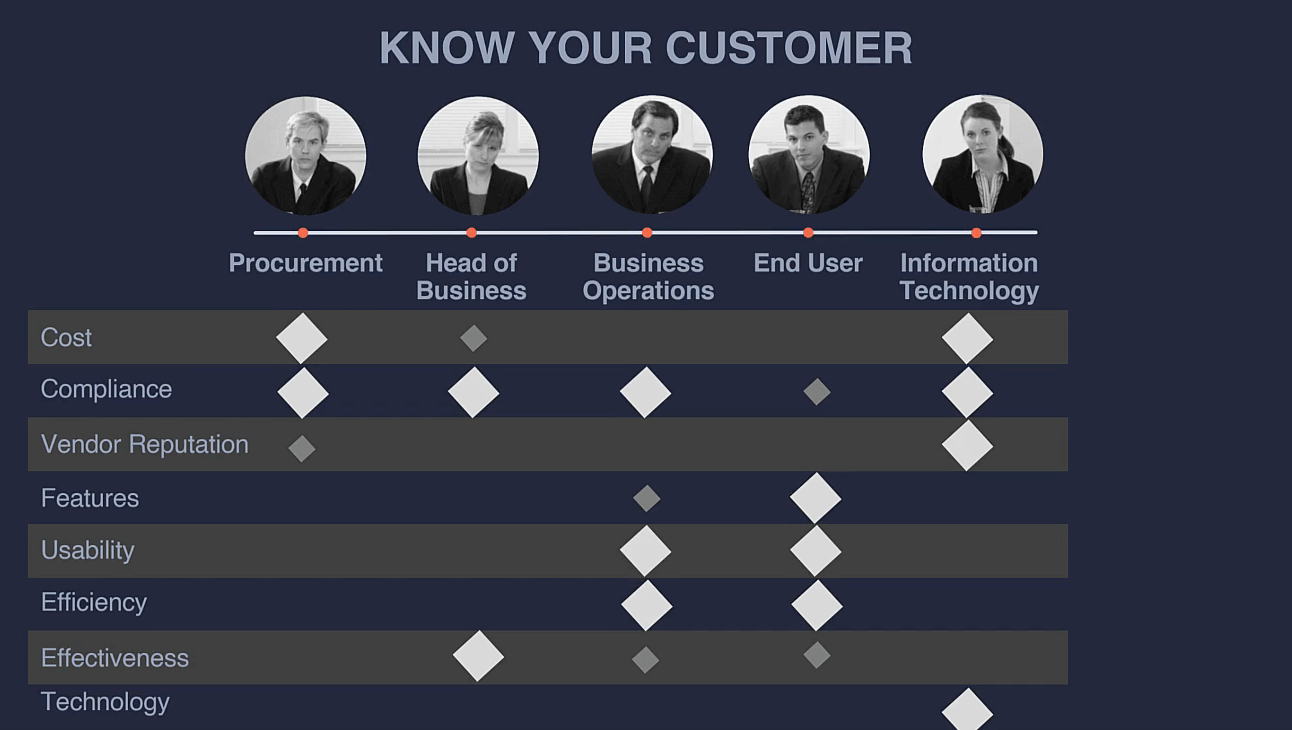
As I said, they're under budget constraints, CFOs are telling them to cut money, so procurement was actually killing deal after deal for us.
Our strategy was to turn that IT person into a soft supporter and then neutralize procurement.
Then we broke it down a little bit further. We mapped it with the key criteria these companies base their decision on and how they map to each individual's roles requirements.
You'll see this kind of misalignment there. Certainly, the business has a certain set of criteria, and procurement as an example doesn't care about those things at all, ironically.
Ironically, the whole purpose of buying this product is to make things more efficient and effective, you can see procurement doesn't care at all.
Know the competition
Then when we met, we mapped ourselves against our competitors to see how we stack rank against them, minus one if we were behind, plus one if we're better.
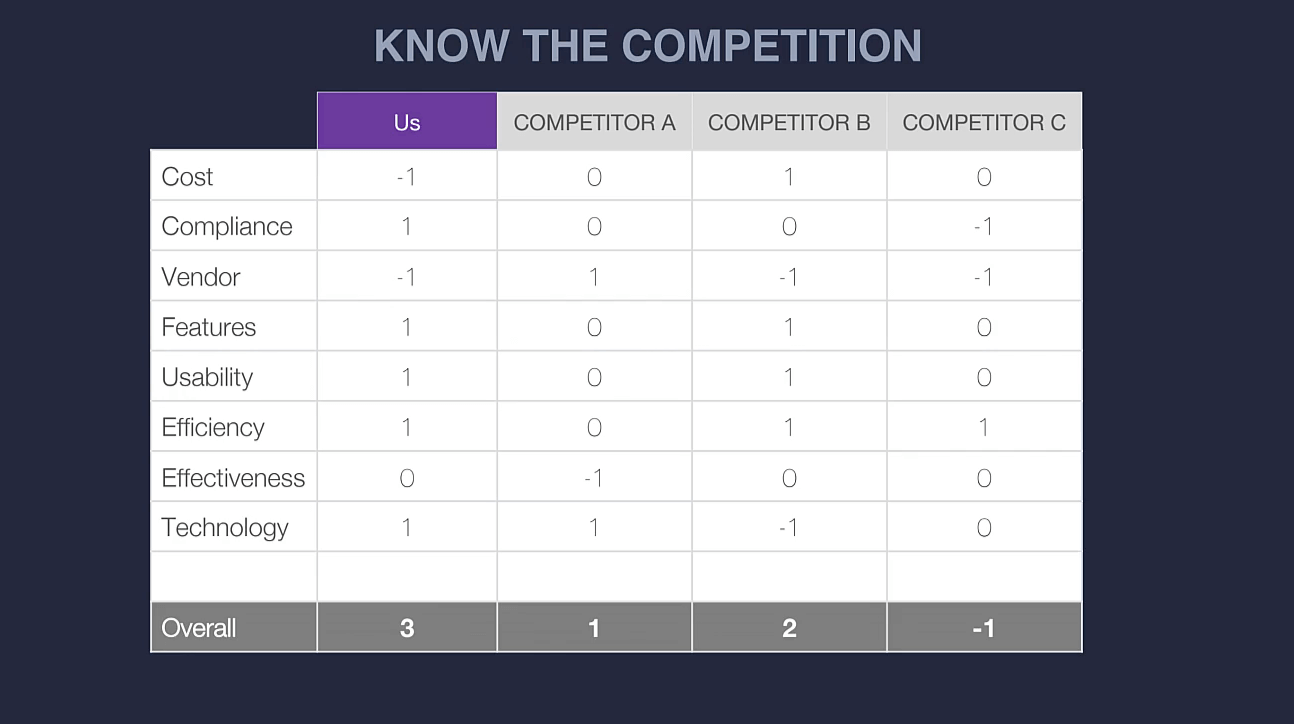
This took a lot of heated debate and discussion, this isn't as clean as it looks on the image, this was two days of arguing over this point to see where we really mapped up. You really have to be honest with yourself.
You can see at the end of the day, we come out ahead, but again, not enough to justify that high price we're offering. We were not about to drop the price of our product, because we felt the value was there.
Differentiate
But because we had brought all of those people together in one place, and this was the key factor we didn't even realize until after the fact, we gleaned some insights.
We had heard over time in various parts of the organization that we had this very strong community, this user group of professionals from this industry, that were purchasing our product, not because they wanted our product, but because they wanted to get into that peer community.
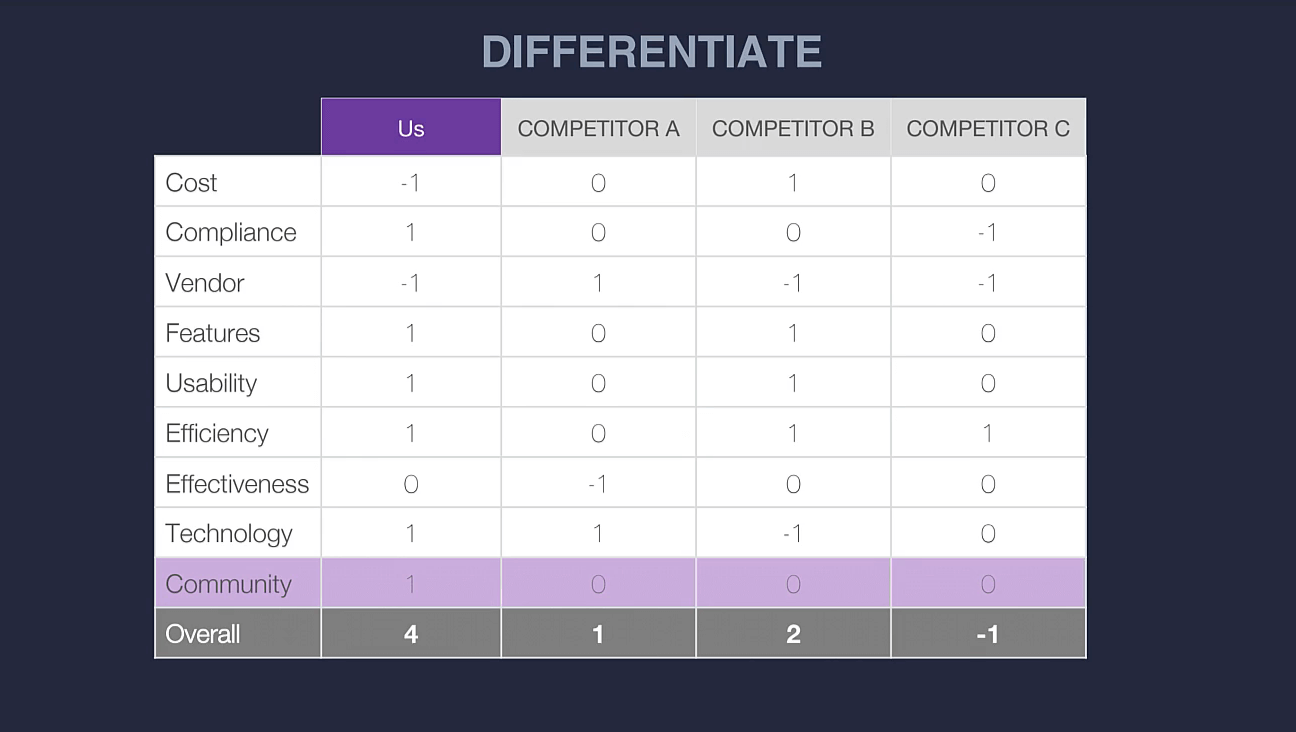
That industry didn't really have a trade association of its own, we were de facto the trade association, because we were the largest ones.
People were purchasing our product to get into that, some of them had told us that, "Hey, our CFO told us to cut the budget and cut your product. We said no because we want to stay part of this user community, we dropped other products instead".
That was an aha moment for us, this is really a strong argument for us. Also note this is a good argument to use with the IT group, which was neutral to us but in this case, we can actually say, "Hey, Mr or Mrs. IT director, we can connect you with hundreds of peers at other companies in this particular industry, IT peers".
Our differentiated value proposition
This ended up being our value proposition here that we went to market with.
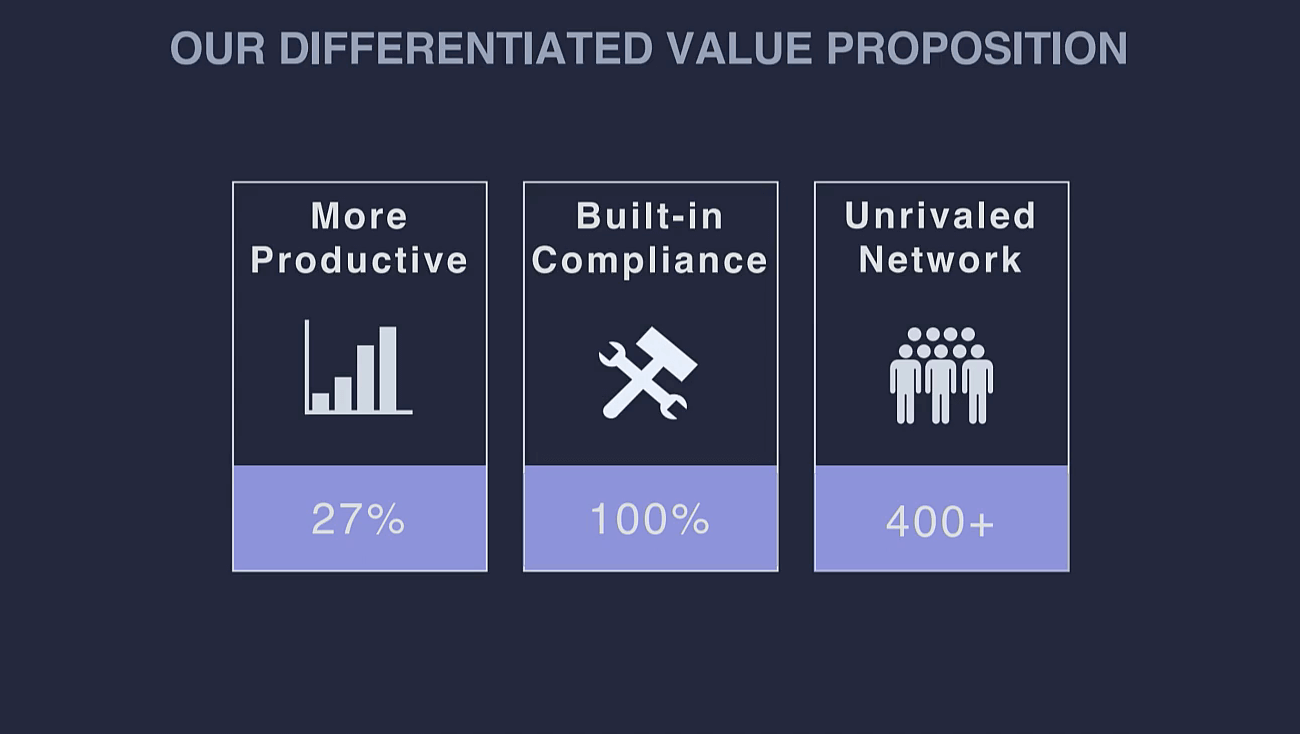
More productive
The core of what they needed was productivity, and we make you more productive.
Built-in compliance
Normally I would say compliance is like usability, you don't want to talk about compliance as a value proposition, especially in a regulated industry, you should be compliant period.
But actually, some of our competitors had not been and we had a perfect track record. Originally, we actually said guarantee compliance, but legal rightfully so didn't like that.
Unrivaled network
As I just mentioned, our network set us apart.
Notice these are value propositions that are business-oriented, they're focused on their needs. They certainly differentiate us in terms of compliance - already the first differentiator, because in terms of productivity by itself we're not the only ones that make it productive, our competitors would have done it as well.
I don't know if we had 27% for competitors, but they would have done it. And then also, I talked about the other differentiation pieces, the unrivaled network.
You have three value propositions we felt comfortable with to go to the market. The end output for that value proposition workshop, those two days was one slide, literally just one slide.
3X3 value proposition matrix
This was it, what we call the three by three matrix with the three customer-centric business benefits up top. Underneath that it's proof points - here's how we do it.
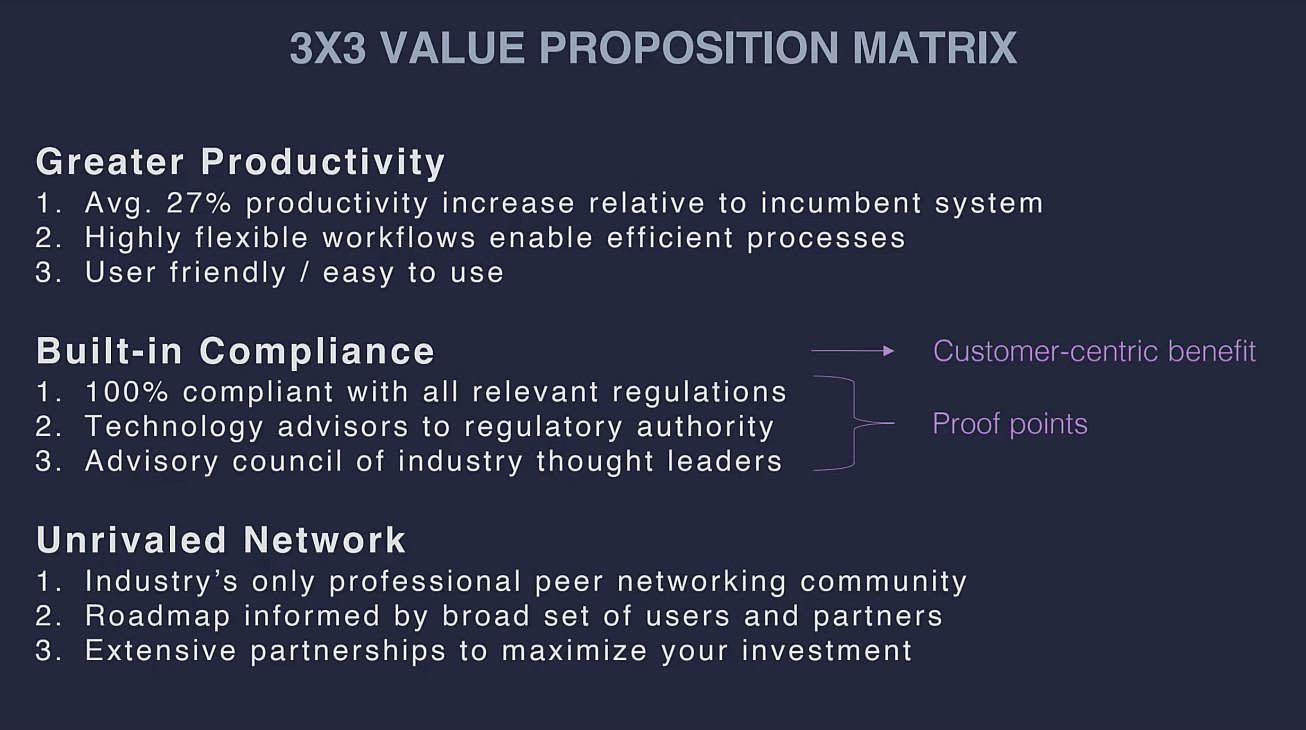
Then there, it's okay to talk about some functionality, that's all right because you want to let your customer know you're not making an empty claim, we're actually able to do it, you want to be able to demonstrate it.
How does a value proposition inform your messaging?
Finally, as I wrap up here, you have to make sure you inform the entire organization with your messaging. Those points need to go through everywhere, that three by three matrix.
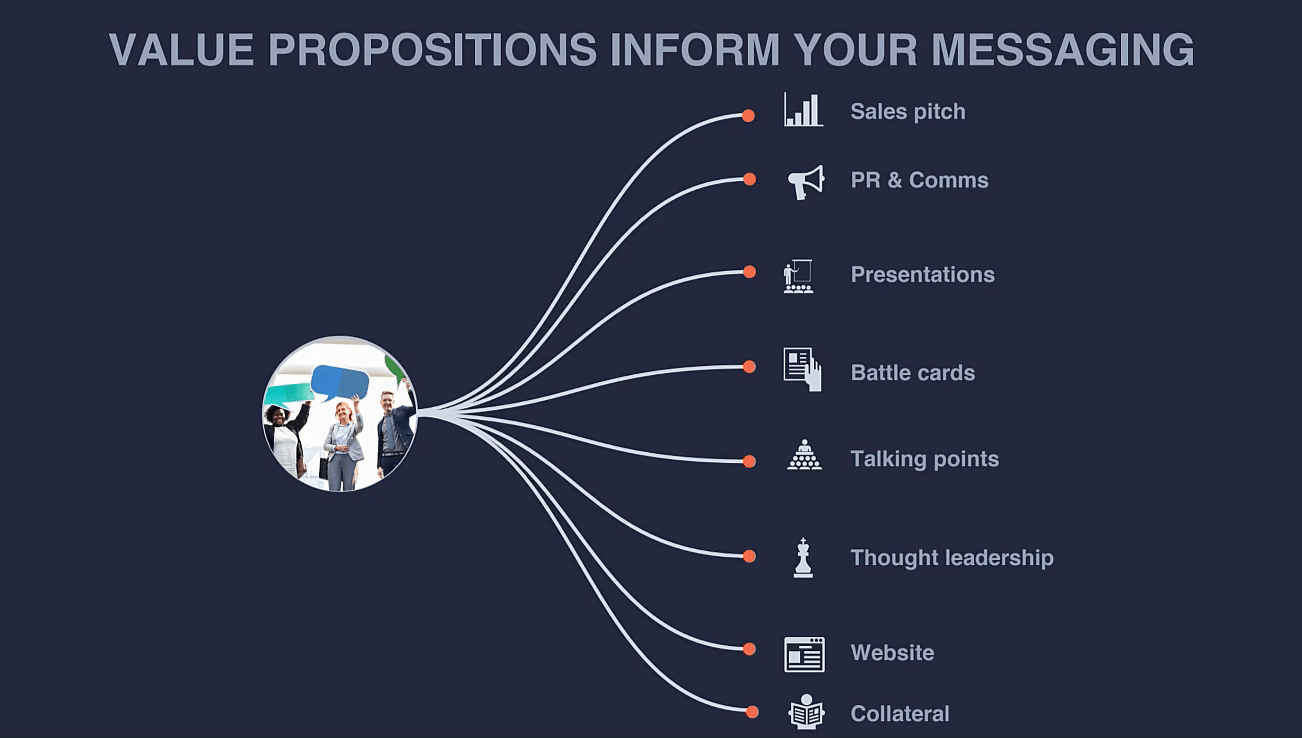
That way, any interaction your customer has with you, no matter which channel, they always hear the same thing.
Pro tip: your own value propositions
I want you to think about your own value proposition for if you ever go to a job interview:
- What are some of the differentiated values you bring that sets you apart from everybody else reading also applying for that job?
- How do you provide business value?
- Do you know what their drivers are?
- Why are they hiring for you in the first place?
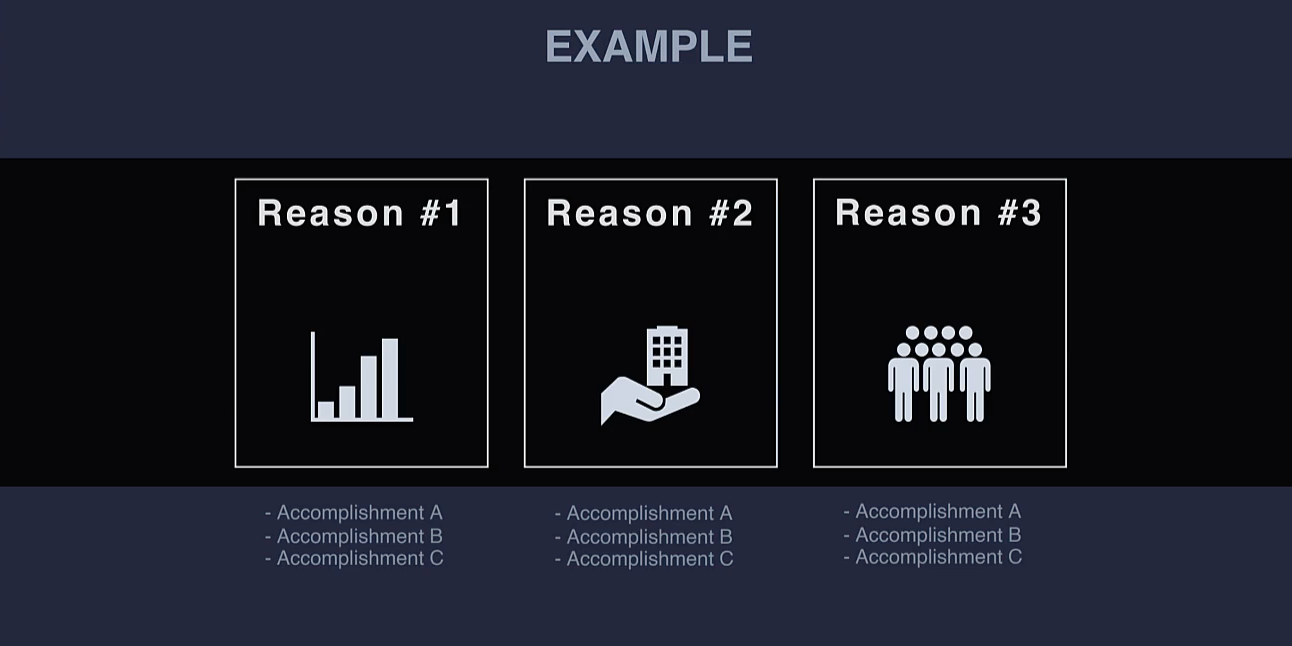
Once you understand that, you can really kind of start to develop your own messaging.
Thank you.

